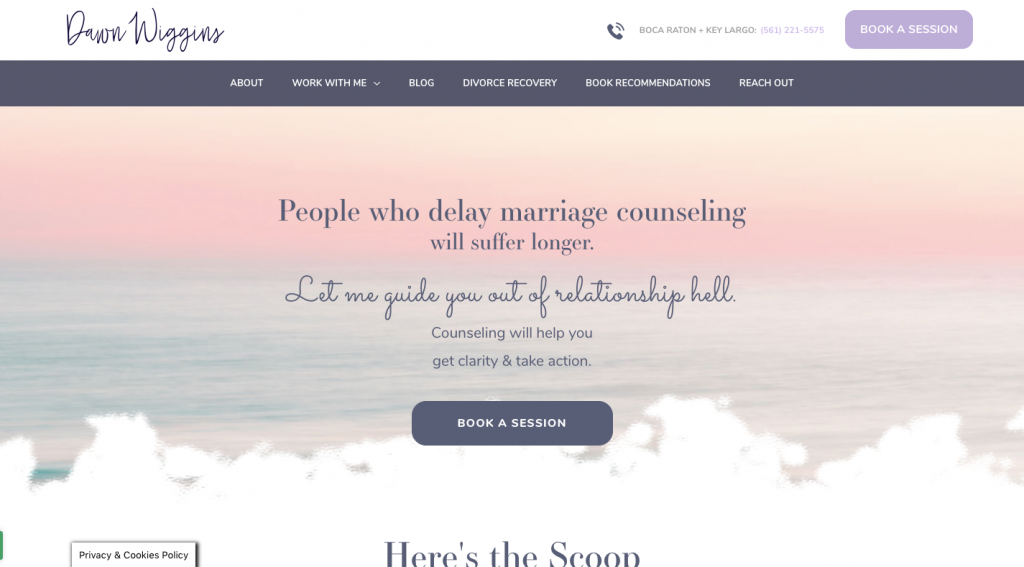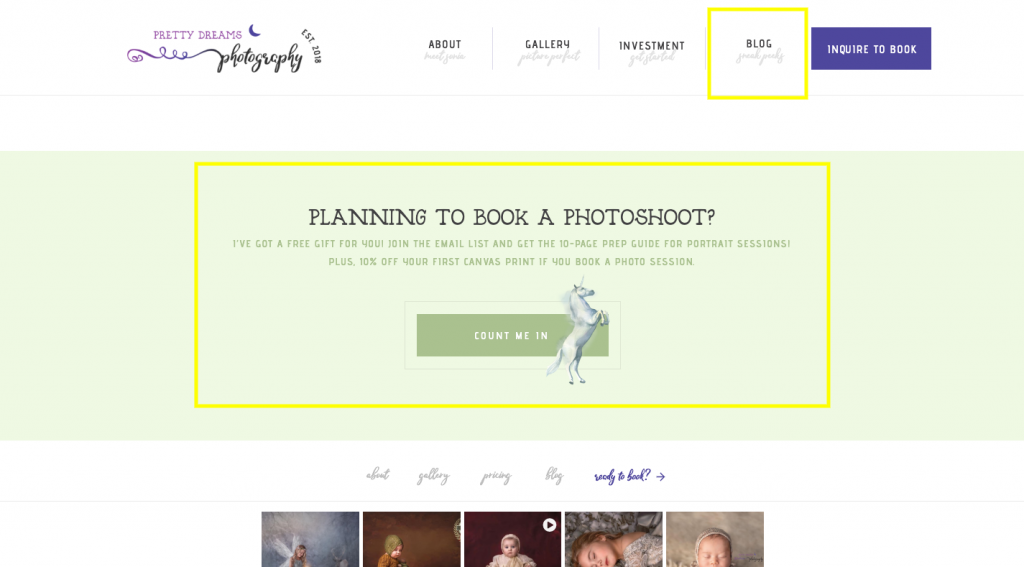Let me ask you something:
Do you ever wish it were easier to get new clients and make more money?
If that’s the case, then I’m going to ask you to hit the “Pause” button on your hustle and take a look around. Are there any obstacles making it difficult for prospective clients to find you, trust you, or hire you?
The truth is, in many cases, it’s your website that’s hurting your business.
If you’re concerned that your website could be holding you back, then keep reading to learn more about the 8 website mistakes that will cost your business.
P.S. At the bottom of this post is a free checklist to help you build a website that does make you money.
8 Website Mistakes That Are Costing You Business

One of the things I see happen time and time again is when business owners and solopreneurs say to themselves:
“I’m gonna build my own website!”
The problem isn’t that you’ve chosen to build your own website. There are tons of website builder tools that make it easy to quickly and cheaply create a professional website.
The problem with this approach is that it doesn’t take into consideration the fact that there’s more to a website than just having a great-looking design or well-written content.
Sadly, many business owners who build their own websites don’t know this and are disappointed when — months or even a year down the road — the website isn’t helping their business. The reality is, it’s actually hurting it.
I don’t want this to happen to you, so I’m going to share with you the 8 most destructive website mistakes people make.
Mistake #1: You Don’t View Your Site as an Asset
You know how when you’re first starting in business and everyone has advice on all the things you “need”? A website isn’t some throwaway thing you have to spend money on.
When you build a website with careful planning and intention, you can turn it into a powerful client-attracting and money-making asset.
So, first things first: you need a change of mindset if you’re going to fix your problem.
Mistake #2: You’re Still Using the Site You Built in 2010
A website isn’t just a place to store information about your company or to give prospects a way to sign up for discovery calls. It should be an ever-evolving thing. As your business grows and changes, so too should your website.
Can you imagine if this were still my website?

Yes, this really is my website from 2010.
If you don’t regularly update your website, your design and content will quickly grow stale. And your prospects will no doubt feel like they’ve just walked into a store with no staff in sight.
Mistake #3: It’s Not Responsive
The technology we use to access the web has changed a lot over the last 20 years. Not only that, but consumers’ usage of technology has changed, too. For instance, did you know that more people visit websites from their mobile devices than computers or tablets?
That’s why your website needs to be fully responsive. That means it adapts to any screen size it’s viewed on. So, if you’re using a theme that calls itself “mobile-friendly”, run! It needs to be responsive and ready to fit to any and all screen sizes.
Mistake #4: It’s Full of Bad Stock Photography
Love them or hate them, stock photos are a big part of web design. That’s because they can help fill the gaps in your visual story when you don’t have photos or designs of your own.
Then again, there are some really bad stock photos out there. Ones that are:
- Outdated
- Irrelevant
- Cliche
- Offensive
- Non-inclusive
- Downright ugly
Your best bet when using stock photography? Keep it simple.
For example, this is the website of Dawn Wiggins:

The hero image is a good representation of where she conducts her business while also giving off a positive, uplifting vibe. You can see another subtle use of stock photography down below:

This is a great way to promote a lead magnet (e.g. a free downloadable) without being overwhelming.
Just don’t forget to put a real photo of yourself somewhere on the site as we’ve done with Dawn here:

You’re in the business of serving people — online or in the real world — so let them see your face.
Mistake #5: Your Content Is Difficult to Read
It’s not just bad imagery that gets in the way of your success. Your content can be problematic as well.
Here are some of the more common content-related website mistakes:
- Unclear messaging about what you do or how clients benefit from it
- Too much text
- Too little text
- Keyword-stuffed text
- Lack of formatting
- Spelling and grammatical errors
If your website gets plenty of visitors, but you’re not booking new business, it’s probably time to hire a copywriter to help you clean up your site.
Mistake #6: There’s No SEO
SEO is a complicated matter as it goes beyond just the keywords used in your content. That’s why this is one of the more common reasons a website fails to do what it’s supposed to do.
To do a better job of optimizing your website for search, you have to create a flawless journey for your users. And unless you’re comfortable managing the technical bits of your website (like web hosting and plugins), you may need a web developer or agency to help with this.
Just make sure that whoever you hire isn’t just doing keyword optimization. Look for a full website maintenance and management package, which will take care of most of what you need.
Mistake #7: Stuff Doesn’t Work
Consumers these days expect the web to work. End of story. Period. So, when they encounter a website that loads too slowly, that has broken links on it, or that has a contact form that won’t accept their submission, they’re not going to look too favorably on the brand who owns the site.
It doesn’t matter if they don’t understand the underlying technology of a website. They know that others make it work… so why can’t you?
Again, a web developer or agency would really come in handy for this. Because they’re familiar with these kinds of website mistakes, they can mitigate for them in the future, too. It’s the only way to ensure that you’re making the best impression every time someone arrives on your website.
Mistake #8: It’s Clear You’re Only Focused on the Sale
Your website has to be more than just a place where prospects can schedule a discovery call or purchase one of your monthly plans.
What about the people who aren’t ready to take action yet? They want help figuring out if it’s worth doing on their own or if the investment in your services makes sense. However, all they find is a “Sign Up” button to get started.
You don’t want your website pushing away perfectly good prospects or followers, which means you have to stop solely focusing on the sale. Instead, find ways to foster a relationship with them on the website.
Blogging is a great way to do this. It allows you to have a conversation with them before you ever meet. You can also use lead magnets and sales funnels to help prospects test the waters with something super valuable (like a free ebook or webinar).
There’s a great example of each of these relationship builders on the Pretty Dreams Photography website:

If you make the site be about them and what you can do to make their lives easier, they’ll eventually be willing to follow the pathway you’ve laid before them.
Wrap-Up
So, now that you know which website mistakes are holding your business back, it’s time to focus on what you can do to turn this ship around.
As promised, I’ve included a free website needs checklist here:
This checklist, “Everything Your Website Needs Before You Hit the ‘Publish’ Button”, will provide you with everything you need to turn your website into a valuable asset.
If you’ve gone through the list and are struggling to get some of the tasks done, please give me a shout. I’ve built hundreds of websites for clients and am more than familiar with each and every one of these brand-boosting optimizations!
Psst...before you go! Get our FREE e-book:
how to attract, delight and close more clients
PLUS GET DESIGN TIPS, ADVICE & FREEBIES DELIVERED TO YOUR INBOX
DOWNLOAD THE EBOOK
Ashley Gadd
Written By:
Ashley Gadd is an award-winning business brand strategist, website designer, and educator who helps clients turn their ideas into captivating and strategic brands that convert. Blending her background in nonprofit marketing with her education in design, Ashley offers customer-centric brand experiences that connect the visual and strategic dots providing her clients the tools to build a sustainable and profitable business they’re proud of.
Brand Strategist - Website Designer - Educator
Leave a Reply Cancel reply
Anything is possible. Explore more.
CONTENT MARKETING
Case Studies
BUSINESS STRATEGY
WEBSITE
BRANDING
Sales Funnels
Let's be Friends!
Connecting the design and marketing dots to create a visual story that captures your shine and shares your message and mission in style.
Use this worksheet to bring more clarity to your business! Let this be your first step before you tackle your ideal customer profile and buyer persona.
FIND YOUR NICHE WORKSHEET!
DOWNLOAD THE WORKSHEET
Stick Around!
and bring much-needed clarity to your business.

JOIN IN THE CONVERSATION